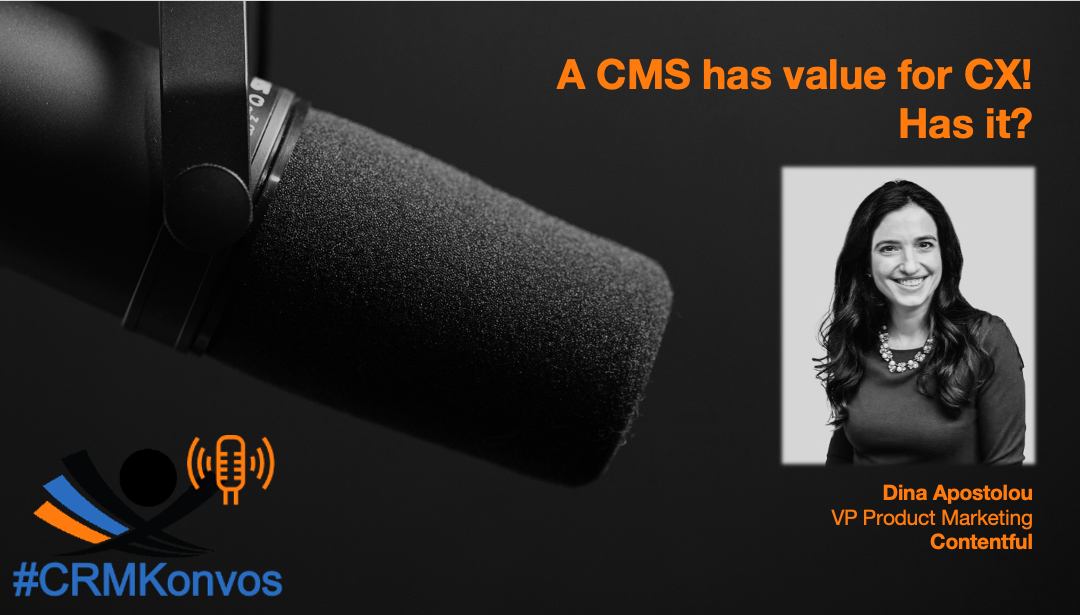
by twieberneit | Jan 4, 2022 | Blog, CRMKonvos |
Everybody is talking of “creating customer experiences” – even I, although I am convinced that any experienced is created by the person on the receiving side of an engagement. But then, how to formulate this in only a few words? Nevertheless, when it comes to engaging with customers or prospects, we are immediately also talking content, be it images, texts, videos, podcasts, 3D rendered objects, or whatever the future will bring us. We are also talking about more than just marketing processes, but also service- or employee-facing processes. Which brings us into the realms of knowledge management, product information management, web content management, enterprise content management and enterprise search. Or the question about how the same content can be used in different scenarios? How can it be found, so that it can be made available? Does it need a platform? What type of platform? Looking at individualised marketing campaigns that theoretically ask for individually tailored content. How much can this scale? Where is the limit? Spoiler here: Manpower to create the content … Still, how is a technology stack helping marketing, sales and service functions with prepared and personalised relevant information – that then also resonates? What is the role of “headless” in this whole picture? Is headless a thing at all? Shouldn’t be the content headless after all (which then solves the content problem across the metaverse – oops, now I used the buzzword)? Lot’s of unanswered and very interesting and important questions! This creates the perfect need to talk to someone who knows. So, we discussed with Dina Apostolou of Contentful how a content management system can be of help. And...

by twieberneit | Nov 14, 2019 | Analysis, Blog |
The News In the past month, Salesforce made announcements around some interesting topics. First, beginning of October, the company introduced Einstein’s Guide to AI Use Cases, a web tool that is targeted at helping businesses identify viable use cases and provide some information about what it takes to support it. It starts with information and videos that explain AI, terms around AI and give some examples how AI can help improve different aspects of a business. According to Sarin Devraj, Associate Product Marketing Manager Salesforce Einstein, for time being the site covers some fifty use cases but will be updated regularly to increase the coverage of relevant and interesting use cases. The website is intended to be top-of-funnel. The second and more recent announcement was about introducing Lightning Order Management, which shall enable brands to deliver end-to-end commerce experiences from shopping to shipping. Lightning Order Management is currently in beta and will be made available later this year. Right now it focuses on B2C processes. Based upon Lightning and enabled by Salesforce’s vast partner network, Lightning Order Management offers a low code platform that helps companies to easily create order management flows, including some partner applications. Salesforce expects the number of partner applications to increase steadily. Lastly, in the beginning of November, Salesforce announced its own Salesforce CMS, a hybrid content management system designed to help easily create and deliver content across channels. Salesforce CMS is designed to be simple, fast yet flexible, and closely connected to the Salesforce infrastructure. For time being Salesforce CMS is geared towards the Salesforce B2C e-commerce solution, but shall be extended to support...

by twieberneit | Mar 31, 2017 | Blog |
Today’s customer service requirements are getting ever more complicated for businesses. Customers encountering problems increasingly rely on self-help. Customers may start looking for solutions by searching on Google, on community sites, or inside a mobile app. A logical starting point depends on the device and application, as well as personal preferences. The bottom line is: customers want to get to their solution as quickly and easily as possible, and they do not want to change their habits and preferences in order to reach support. Many companies run several customer service applications that support different channels, each with a separate knowledge base (KB) subsystem. These may include a support application for an ecommerce site, some general help pages on the company web site, and FAQs on a mobile application. For internal purposes, there might even be an Enterprise Content Management (ECM) system with information for contact agents to use but that are not published externally. Of course the normal situation for a service agent is to work on more than one channel. This means that depending on the nature of the inquiry, agents need to use and update multiple knowledge bases. This results in additional, redundant work and information. Furthermore, information gets easily out of sync—resulting in confusion. Similarly, customers need to navigate through different knowledge bases and FAQs. Apart from being highly inefficient and ineffective, this has an impact on both employee satisfaction and customer satisfaction. It leads to frustration because customers who do not find their solution need to relay the same information multiple times, and they could be put on hold while the agents research different databases,...




